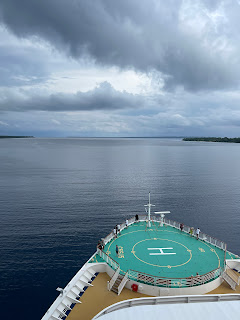Almost overnight Luganville was transformed into a massive forward base for the American forces. Known as Button Base, it included four separate airfields, five military hospitals, a seaplane base, pontoon wharf, a floating dry dock, a barracks village, and thousands of Quonset huts. At its peak the base hosted more than 100,000 troops, with more than a hundred vessels anchored in its deep and sheltered harbour.
Building all of this infrastructure required tens of thousands of tonnes of equipment to be shipped to Luganville. By the end of the war, 9 million tonnes of equipment had been shipped there and over 500,000 servicemen and women had spent some time on Espiritu Santo.
Our tour also visited the infamous Million Dollar Point. This landmark got its name after the Americans dumped millions of dollars worth of military equipment into the sea. As the Americans demobilised, its residual goods—everything from weaponry to bottles of Coca-Cola—were offered to the French and British at a very low price, 6 cents to the dollar.
However, the Europeans rejected the offer believing the U.S. military would ultimately have to leave everything behind for free. The Americans were not impressed. To spite the British and French, the army drove all of its vehicles, food, clothing, drinks, and other equipment to a temporary wharf on the southern coast of the island.
It then drove every vehicle into the sea, used bulldozers to dump the rest of its supplies over the edge of the wharf, and then drove the bulldozers into the sea. Over a two-day period, this insanely wilful act ensured that the Europeans never got their hands on the items, free or otherwise.
However, the Europeans rejected the offer believing the U.S. military would ultimately have to leave everything behind for free. The Americans were not impressed. To spite the British and French, the army drove all of its vehicles, food, clothing, drinks, and other equipment to a temporary wharf on the southern coast of the island.
It then drove every vehicle into the sea, used bulldozers to dump the rest of its supplies over the edge of the wharf, and then drove the bulldozers into the sea. Over a two-day period, this insanely wilful act ensured that the Europeans never got their hands on the items, free or otherwise.
Today, the rusting remnants of this mechanical graveyard lie scattered along the shoreline and in the pounding surf. It’s probably one of the oddest war relics I’ve ever encountered. During our visit to the point, we saw a few cruise passengers on another tour snorkelling around the rusting hulks located ten metres or so offshore. We also discovered dozens of miniature hermit crabs crawling through the shoreline wreckage. These tiny creatures have dull green shells and are less than a centimetre long.
After the tour, we stopped to listen to a local group playing native musical instruments on the dock. They were raising funds for disabled members of the local community. We’d seen several of these instruments on display in the National Museum yesterday so it was awesome to finally hear them being played.
NOTE: 7 January
We were scheduled to visit Mystery Island after our day in Luganville. However, a medical emergency onboard our ship saw us skip this port. You can read more about our revised itinerary here.

















No comments:
Post a Comment